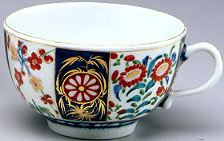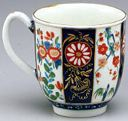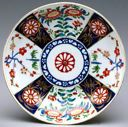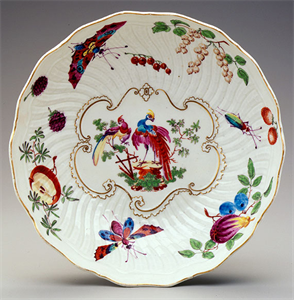
Worcester Porcelain Factory
English, born established 1751
Worcester looked primarily to the East for inspiration during its founding years, no doubt as a way to compete with Chinese export porcelain. Decorative motifs included flowers, fanciful birds and landscapes. The Asian influence can also be seen in Worcester's use of Japanese Kakiemon patterns, such as is seen in this cup and saucer trio. Kakiemon porcelains favored "famille verte" colors and typically featured flowers, animals or birds perched on or beside a tree, with a border of floral or diaper design.
Because trade with Japan, including imports of Japanese porcelain, was suspended in the early eighteenth century due to in part to Japan's isolationism, Kakiemon was not available in England except for those services already in use prior to 1740. However, because of their popular appeal, Worcester created its own versions of Kakiemon, as did other ceramics houses. These adaptations were an important and successful component of Worcester's production in the late 1760s to mid-1770s.
This trio is decorated in a style based on early Japanese Imari porcelain. Called the Queen's pattern, the design consists of panels of cobalt blue painted with orange-red chrysanthemum heads alternating with panels of Kakiemon-type flowers and prunus branches. As is typical of this style, the decoration overwhelms the white body.
Visual Splendors: First Period Worcester Porcelain from the Loeb Collection, 1997
English, born established 1751
Teacup
about 1765–1770
Object Type:
Ceramic
Creation Place:
Northern Europe, English, Worcestershire
Dimensions:
2 in. x 4 in. x Diam: 3 1/4 in. (5.08 cm x 10.16 cm x 8.26 cm)
Medium and Support:
Porcelain
Accession Number:
1990.0009.0014.0001
Credit Line:
Gift of Mr. and Mrs. James Lucien Loeb
Currently On View
Worcester looked primarily to the East for inspiration during its founding years, no doubt as a way to compete with Chinese export porcelain. Decorative motifs included flowers, fanciful birds and landscapes. The Asian influence can also be seen in Worcester's use of Japanese Kakiemon patterns, such as is seen in this cup and saucer trio. Kakiemon porcelains favored "famille verte" colors and typically featured flowers, animals or birds perched on or beside a tree, with a border of floral or diaper design.
Because trade with Japan, including imports of Japanese porcelain, was suspended in the early eighteenth century due to in part to Japan's isolationism, Kakiemon was not available in England except for those services already in use prior to 1740. However, because of their popular appeal, Worcester created its own versions of Kakiemon, as did other ceramics houses. These adaptations were an important and successful component of Worcester's production in the late 1760s to mid-1770s.
This trio is decorated in a style based on early Japanese Imari porcelain. Called the Queen's pattern, the design consists of panels of cobalt blue painted with orange-red chrysanthemum heads alternating with panels of Kakiemon-type flowers and prunus branches. As is typical of this style, the decoration overwhelms the white body.
Visual Splendors: First Period Worcester Porcelain from the Loeb Collection, 1997
Keywords
Click a term to view the records with the same keyword
Additional Images
Click an image to view a larger version
Related Objects
Click a record to view

Coffee Cup
1990.0009.0014.0002

Saucer
1990.0009.0014.0003
Portfolio List
Click a portfolio name to view all the objects in that portfolio
This object is a member of the following portfolios:
Your current search criteria is: All Object records and [Object]Century is "Eighteenth century".

 by Artist (11)
by Artist (11)

